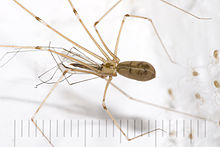
Back عنكبوت الأقباء طويل الجسد Arabic عنكبوت الاقباء طويل الجسد ARZ Pholcus phalangoides Byelorussian Дългокрак паяк Bulgarian Pholcus phalangioides Catalan Pholcus phalangioides CEB Třesavka velká Czech Große Zitterspinne German Pholcus phalangioides Spanish عنکبوت دخمهای تنومند بلند Persian
| Pholcus phalangioides | |
|---|---|

| |
| With cranefly prey (spiderlings visible at right) | |
| Scientific classification | |
| Domain: | Eukaryota |
| Kingdom: | Animalia |
| Phylum: | Arthropoda |
| Subphylum: | Chelicerata |
| Class: | Arachnida |
| Order: | Araneae |
| Infraorder: | Araneomorphae |
| Family: | Pholcidae |
| Genus: | Pholcus |
| Species: | P. phalangioides
|
| Binomial name | |
| Pholcus phalangioides (Füssli, 1775)
| |
Pholcus phalangioides, commonly known as the cosmopolitan cellar spider, long-bodied cellar spider, or one of various types called a daddy long-legs spider, is a spider of the family Pholcidae. This is the only spider species described by the Swiss entomologist Johann Kaspar Füssli, who first recorded it in 1775.[1] Its common name of "daddy long-legs" should not be confused with a different arachnid group with the same common name, the harvestman (Opiliones), or the crane flies of the superfamily Tipuloidea.
Females have a body length of about 8 mm while males tend to be slightly smaller. The length of the spider's legs are on average 5 or 6 times the length of its body.[2] Pholcus phalangioides has a habit of living on the ceilings of rooms, caves, garages or cellars.
This spider species is considered beneficial in parts of the world because it preys on other spiders, including species considered dangerous such as redback spiders.[3][4] Pholcus phalangioides is known to be harmless to humans and a potential for the medicinal use of their silk has been reported.[5][6][7]
- ^ "The Nearctic Spider Database: Pholcus phalangioides (Fuesslin, 1775) Description". canadianarachnology.org. Archived from the original on 6 November 2009. Retrieved 28 August 2016.
- ^ Mazza, Giuseppe (23 June 2016). "Pholcus phalangioides". Monaco Nature Encyclopedia. Retrieved 21 October 2020.
- ^ Daddy Long Legs – Queensland Museum
- ^ FAMILY PHOLCIDAE – Daddy long-leg Spiders
- ^ "Longbodied Cellar Spider". Penn State Extension. Retrieved 21 October 2020.
- ^ Shahbuddin, M.; Puat, N. A.; Mirghani, M. E. S.; Raus, R.A. (2016). "Natural Silk of Pholcus Phalangioides, a Common Home Spider Species for Wound Healing Applications" (PDF). International Conference for Innovation in Biomedical Engineering and Life Sciences. IFMBE Proceedings. Vol. 56. pp. 216–221. doi:10.1007/978-981-10-0266-3_45. ISBN 978-981-10-0265-6. S2CID 87534833.
- ^ Roozbahani, Hassan; Asmar, Mahdi; Ghaemi, Naser; Issazadeh, Khosro (1 July 2014). "Evaluation of Antimicrobial Activity of Spider Silk Pholcus Phalangioides Against Two Bacterial Pathogens in Food Borne". International Journal of Advanced Biological and Biomedical Research. 2 (7): 2197–2199.